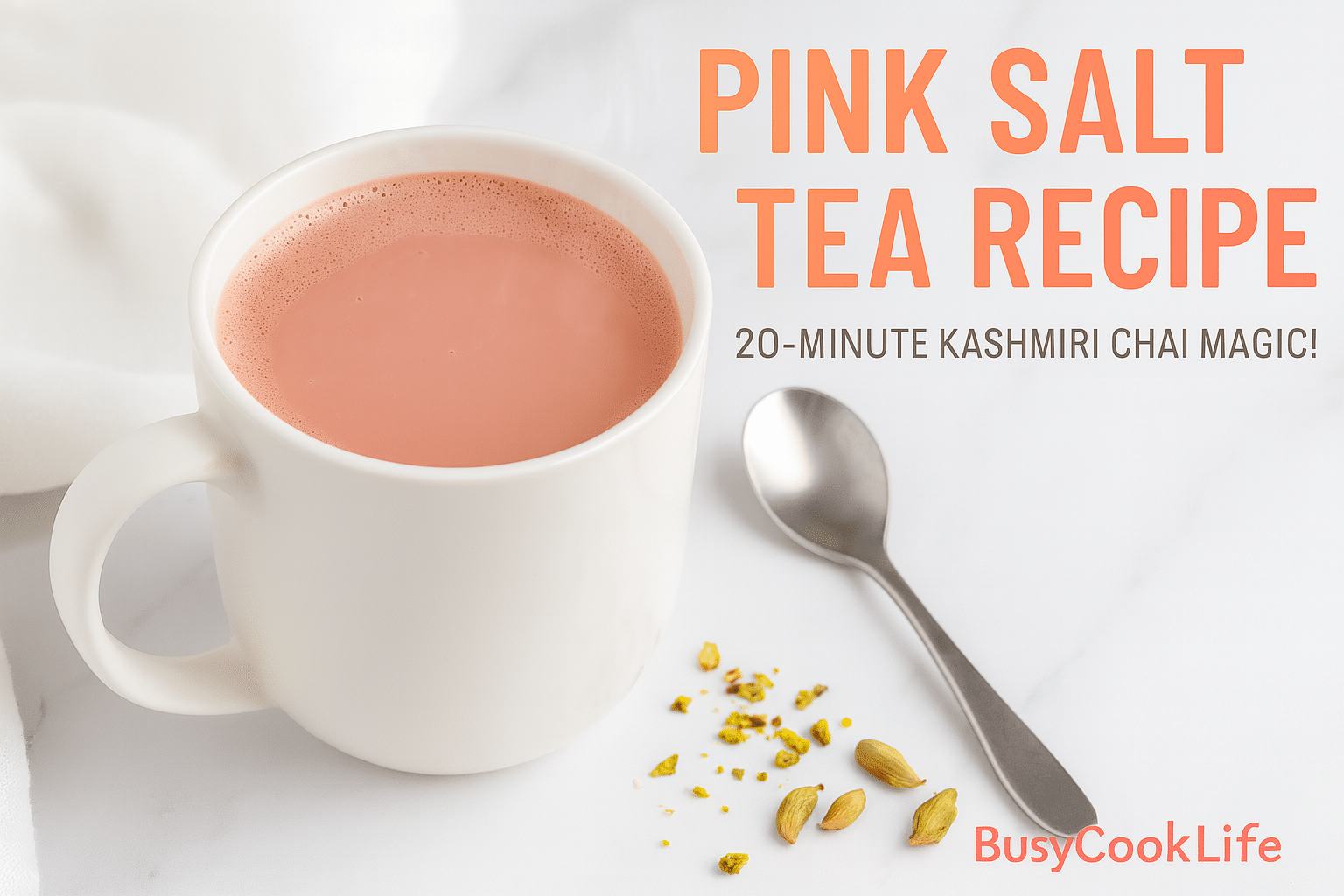I love a small ritual that feels fancy but hardly eats my time. I grab a few pantry staples, boil dark leaves until bold, and shock the brew to coax its true color. It feels like magic — and it happens fast.
So here’s how I do it: I build a strong base, add a pinch of chemistry (just a touch of baking soda), and finish with warm milk and crushed nuts. The moment the brew turns that lovely hue? That’s the cue to stop and sweeten. That moment matters for taste and color.
This is my go-to when the day runs wild. I call it a quick noon chai fix — kind of sweet, a little savory, and totally soothing. I’ll show tools, tweaks, and dairy-free swaps that keep the cup friendly for everyone.
Key Takeaways
- Fast comfort: A repeatable method you can make in about 20 minutes.
- Color cue: Watch the change — it tells you when flavor peaks.
- Simple stash: Basic spices and baking soda do the trick.
- Family-friendly: Sweet-salty balance you can tweak by taste.
- Make ahead: Brew concentrate, reheat gently for weeknight ease.
Cozy Intro: Why my pink salt tea recipe keeps me sane on wild weekdays
When chaos peaks, a quick pan, warm steam, and a cup calm me down. Tiny shoes on the counter. A dog stealing socks. The kitchen feels loud—then I make a small ritual.
I grab the pan, breathe, and start. I boil strong leaves with cardamom and a pinch of baking soda for a fast color shift. I aerate the brew, shock it with cold water, then add milk and a bit of sugar.
This one’s saved my week more than once. It takes little time and gives a lot back. The scent resets my mood. The taste–a touch savory with sweet balance–feels like a hug in a cup.
- Quick comfort: Weeknight calm in about twenty minutes.
- Simple tricks: Soda and aeration speed the pink change so you don’t wait.
When winter creeps in here in Asheville, I make a bigger batch to reheat. No perfection. Just soothing, every single time.
What is pink tea? Noon chai vs kashmiri chai (and why we add salt)
I love how a cup can carry a place with it. For me, kashmiri chai is that cup — a milk-forward drink with a soft blush and nutty finish.
Noon chai literally means “salt tea.” In Kashmir it’s often savory and served hot with bread. The salt balances milk and brightens the overall taste.
Outside the valley, many of us sweeten kashmiri chai. It becomes the chai pink everyone talks about, topped with crushed nuts and a little extra comfort.
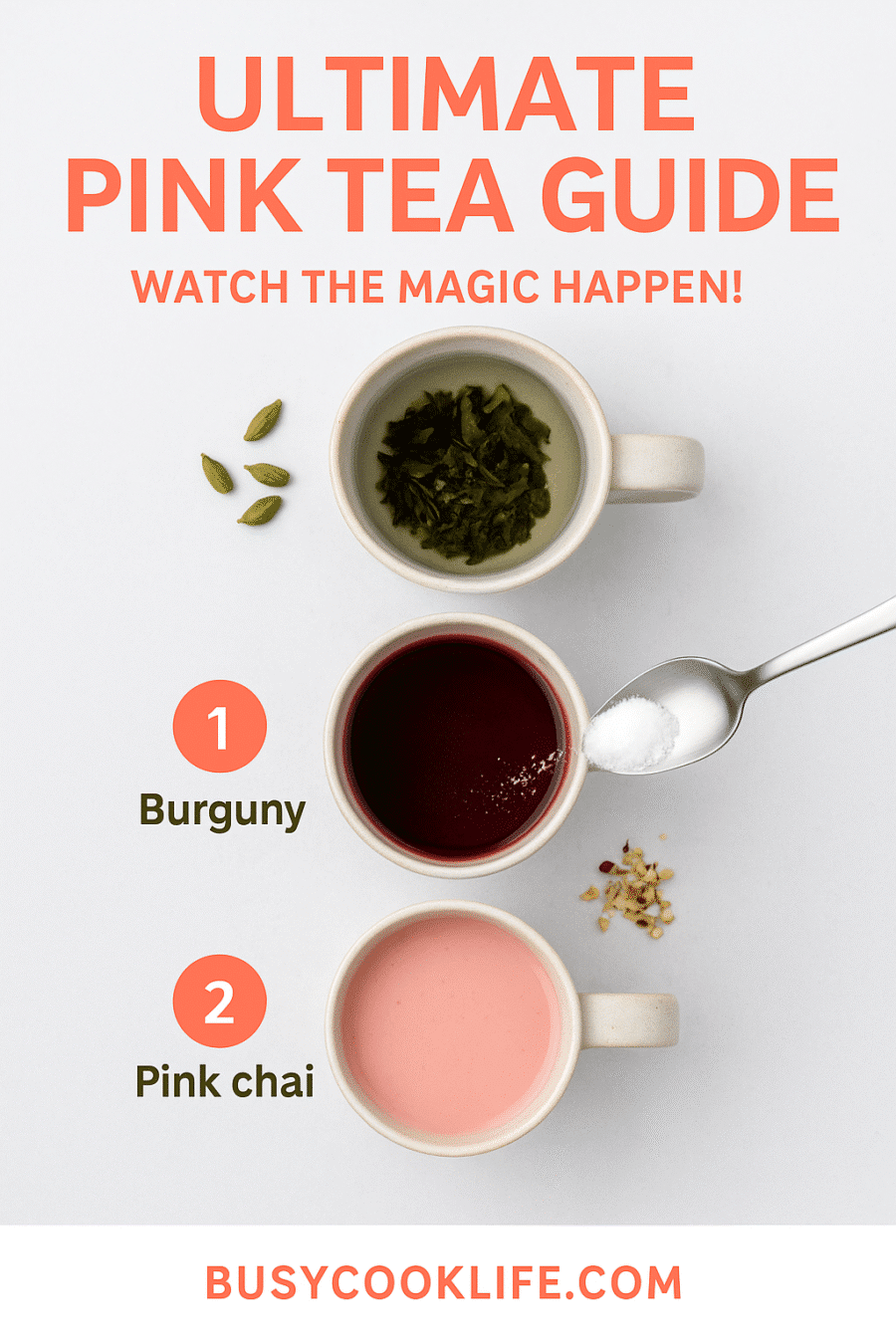
“The pink color isn’t dye — it’s chemistry: a pinch of baking soda, a lot of air, and a cold-water shock.”
Authentic kashmiri versions simmer longer and pair with local breads. At home I keep the soul of the drink but speed the process by using more tea leaves in a wide pan.
- Tea leaves: Use green tea or specific kashmiri tea leaves — both work.
- Spice: Cardamom gives that classic aroma.
- Color process: Baking soda + aeration + cold water = the signature blush.
| Feature | Noon Chai (Kashmir) | Outside Kashmir | Home Quick Method |
|---|---|---|---|
| Flavor | Savory, milky | Sweet-savory, nutty | Balanced, faster brew |
| Process | Slow simmer | Simmer then sweeten | Concentrate tea, shock with cold water |
| Garnish | Bread, local accompaniments | Crushed almonds/pistachios | Chopped nuts, a pinch of spice |
| Key trick | Patience and tradition | Sweetening for wider palates | More tea leaves, quick aeration |
Main ingredients for a reliable pink salt tea recipe
A good cup starts with honest ingredients and a tiny chemistry trick. I keep a short list that makes the process predictable and forgiving. Pick bold components and you’ll get that signature color and rounded taste fast.
Tea leaves and baking soda: picking the right green tea
I use loose green tea leaves or a dedicated kashmiri tea when I can. Loose leaves brew strong and give better control over color.
Add a heaped 1/8 tsp of baking soda as the brew simmers. If the blush stalls, add a very small extra pinch. Too much baking soda tastes off, so go slow.
Milk, half-and-half, and salt: building body and balance
For body, I mix whole milk with a little half-and-half. In winter I nudge the ratio toward creamier; in summer, I use less half-and-half.
Cardamom pods crack easily under a spoon and lift aroma. A tiny pinch of kosher salt rounds the flavors and makes sweet notes sing. Sweeten with cane sugar, brown sugar, or date syrup—whatever you like.
- I choose loose tea leaves for fast, bold brewing.
- Swap dairy for a creamy alt if needed—most alt milks behave well here.
- If color won’t develop, try a different brand of leaves; some just don’t blush.
| Ingredient | Why it matters | Amount for quick version | Swap option |
|---|---|---|---|
| Green tea leaves | Strong base and color potential | 2–3 tbsp loose | Kashmiri tea leaves or robust green tea bags |
| Baking soda | Triggers color change | Heaped 1/8 tsp (tiny pinch more if needed) | Try different leaves if extra soda tastes off |
| Milk & half-and-half | Gives body and creaminess | 3/4 cup milk + 1/4 cup half-and-half | Oat or soy creamer for dairy-free |
| Cardamom, salt, sweetener | Aroma, balance, and finish | 2–3 pods, pinch of kosher salt, sugar to taste | Optional cloves, cinnamon, star anise |
Gear and pantry check: the tools that make color happen
Most of the magic lives in a few simple tools you already have. I keep things basic so I can move fast on busy nights. A wide pan, a sturdy ladle, and a cup of cold water make the whole process feel foolproof.
Wide pan, strong boil, quick aeration
I grab a wide pan so the brew reduces fast and takes on air while it bubbles. A broad surface speeds evaporation and helps the leaves show their best.
I bring boil with the leaves and spices, then ladle up-and-down to increase oxygen. That up-and-down motion nudges the color along without endless simmering.
Cold shock, measured moves
I keep a cup of ice-cold water ready—ice bath cold—so I can shock the pot at the right moment. I don’t drop ice cubes in; I pour cold water to keep measurements steady.
- Sturdy ladle: for aeration and lifting the brew.
- Fine strainer: for a clean pour.
- Small measuring spoon: for that tiny baking pinch.
- Timer: so I don’t miss the bring boil window.
“Watch the foam—when the surface shifts hue, you’re on track.”
| Tool | Purpose | Quick tip |
|---|---|---|
| Wide-based pan | Speeds reduction and aeration | Use medium-high heat for a bold boil |
| Sturdy ladle | Lifts and oxygenates the brew | Ladle up-and-down for 30–60 seconds |
| Cup of cold water | Cold shock to deepen kashmiri pink | Pour water, don’t add ice cubes |
| Fine mesh strainer | Removes leaves and spices | Strain after adding milk to keep color bright |
Quick confidence boosts: keep spices within reach, measure baking from your smallest spoon, and add milk last. Simple gear, bold boil, quick moves—that’s how I get reliable kashmiri chai on a weeknight.
Pink salt tea recipe (quick, weeknight method)
So here’s how I do it on busy evenings — fast, fragrant, and reliably blushing.
Build the kahwa: boil leaves with cardamom and baking soda
I set a wide pan over high heat and add 3 cups of water, 2–3 tbsp green tea leaves, and 2 lightly crushed cardamom pods.
I bring it to a roaring boil, then sprinkle in a heaped 1/8 tsp baking soda. It fizzes — stir and keep moving the ladle.
I aerate the brew with the ladle for about 5–6 minutes until the foam deepens and the liquid reduces.
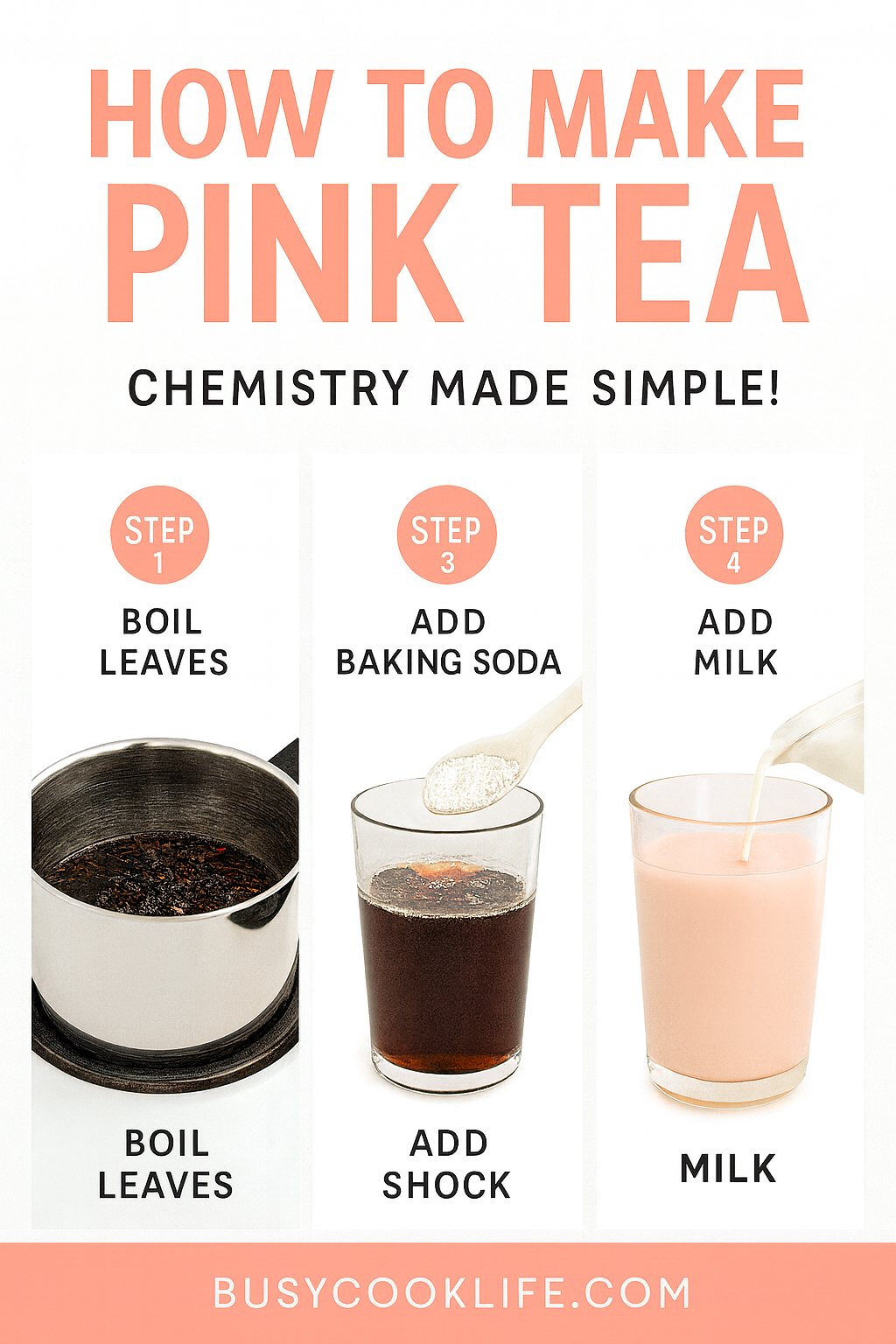
Shock with cold water, then add milk and salt
When the surface shows that deep shift, I pour in about 1 cup of ice-cold water (no cubes). That cold water shock deepens the color fast.
I let the pot settle to a simmer, then I add 3/4 cup milk plus 1/4 cup half-and-half for body.
I add a tiny pinch of salt and sugar to taste. Then I bring it to one brief boil and cut the heat so the pink color stays lively.
Strain, sweeten to taste, and pour
I strain into cups and top each with crushed almonds and pistachios. A final taste check — sweeten if needed.
If I want an iced version, I cool a portion and add ice when serving.
“A quick cold-water shock and a short boil after milk keep the color vivid and the flavor bright.”
| Step | What I do | Tip |
|---|---|---|
| Boil | Add water, leaves, cardamom; bring boil | Use a wide pan for faster reduction |
| Add baking soda | Heaped 1/8 tsp; expect fizz | Stir and aerate with a ladle |
| Cold shock | Pour 1 cup cold water | Deepens hue without diluting too much |
| Add milk & finish | Add milk and half-and-half, salt, sugar; one quick boil | Cut heat right after the brief boil to protect color |
The color science: baking soda, aeration, and the cold-water shock
A quick sequence—soda, ladle, cold water—creates the blush I look for. I keep the steps simple and repeatable. No heavy science talk here—just what works in my pan.
From pale green to deep burgundy to pink
I start with a pale green brew from bold green tea leaves. A small hit of baking soda nudges the brew. It neutralizes acidity and helps pull color from chlorophyll-based compounds. The liquid shifts toward burgundy as it oxidizes.
Then I oxygenate the pot by ladling the liquid high and pouring back. That aeration deepens the hue fast. When the surface looks rich, I pour in a splash of ice-cold water. That shock seals the change and makes the pink color pop once I add milk.
How much baking soda is just enough
I use a heaped 1/8 teaspoon to start. Some batches stall and need a bit more—up to 1/4 teaspoon total. I add in tiny steps and taste as I go.
- Start small: heaped 1/8 tsp baking soda.
- Aerate: ladle up-and-down for 30–60 seconds.
- Cold water: pour a cup of ice-cold water to finish the shift.
- Watch milk: long boiling after milk can fade the color—keep the final heat short.
“A little soda, lots of air, and a cold shock—that’s the simple process that turns ordinary leaves into kashmiri pink.”
| Step | Why it helps | Quick tip |
|---|---|---|
| Add baking soda | Neutralizes acidity, releases color | Heaped 1/8 tsp, increase in tiny amounts |
| Aerate | Oxidizes the brew, deepens hue | Ladle high and pour back for a minute |
| Cold shock | Sets the color before milk | Use ice-cold water, not ice cubes |
Troubleshooting: when your pink tea stays tan
If the brew reads more tan than blush, I don’t panic—I run a spoon test. Here’s what I try first. Pull a spoonful of concentrate, add a splash of milk, and check the blush.
If it’s still tan, I add a tiny pinch of baking soda and bring it back to a quick boil for one minute. Then I test again. I keep changes small so the taste stays balanced.
I aerate more next. I ladle higher and pour back for a solid minute. A wide pan and steady heat help the color develop faster.
If that fails, I swap tea leaves. Some brands of green tea simply won’t turn. Brewing the kahwa a bit stronger for a few extra minutes often helps the flavor and color.
- Cold shock: use truly cold water or ice—lukewarm won’t cut it.
- Avoid over-boiling after milk: long boils dull the pink color and flatten taste.
- Keep tasting: tiny tweaks keep balance in check.
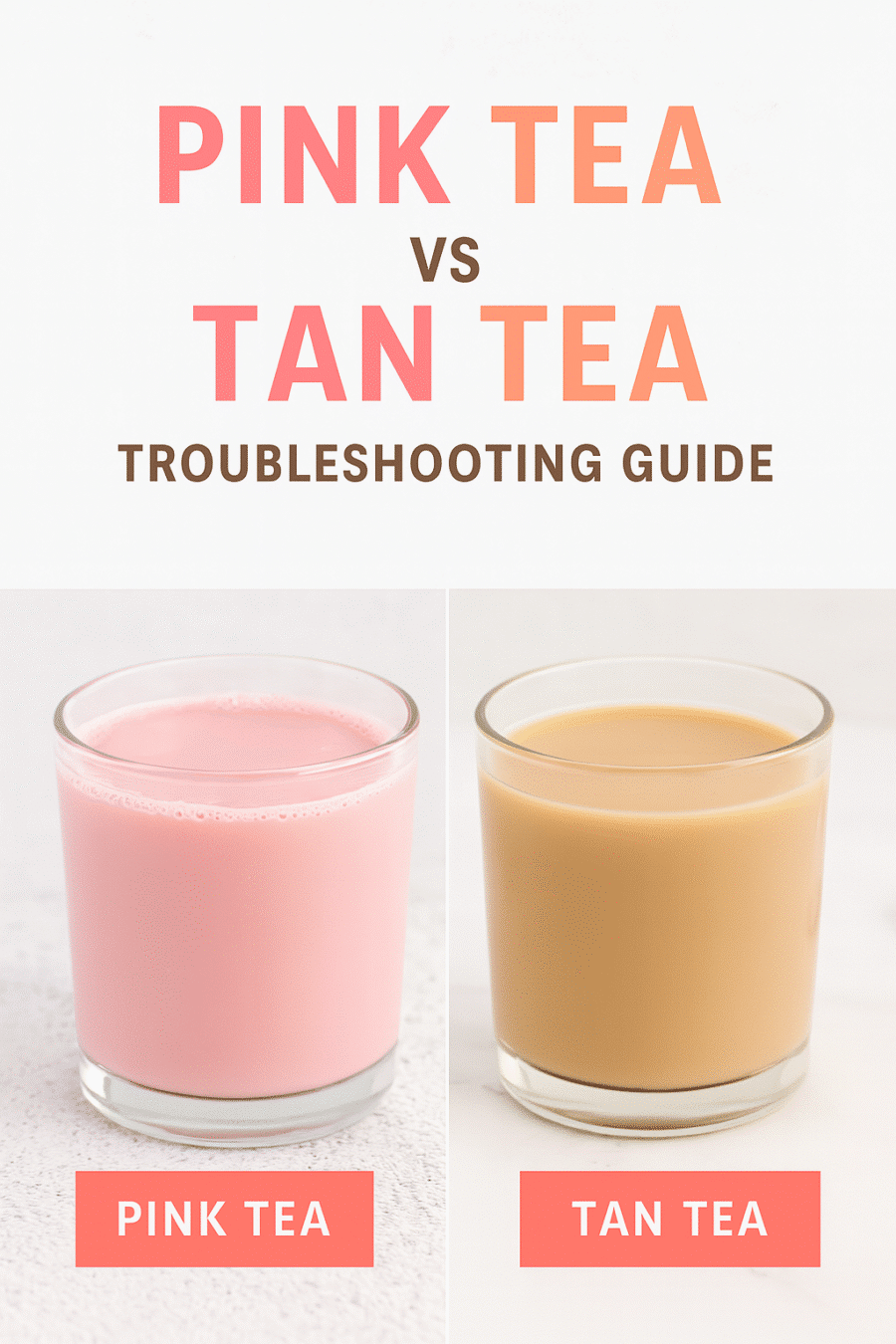
“Small tests and small tweaks beat panic every time.”
| Issue | Quick fix | Why it works |
|---|---|---|
| Too tan | Spoon test + add baking soda | Shows blush fast; soda releases color |
| Weak flavor | Brew base longer (few minutes) | Concentrates leaves and aroma |
| No change | Swap green tea leaves brand | Some leaves lack color potential |
| Faded after milk | Short, final boil only | Prevents color loss and off taste |
Variations I love: iced, extra creamy, or nutty and spiced
I like options: a chilled pour for summer, a cozy, creamy mug for winter. Small tweaks change mood fast. You use the same base and finish it to fit the moment.
Iced finish
Let the brew cool to room temp. Then chill it in the fridge for a bit and pour over a tall glass with a couple of ice cubes. I often add ice right before I sip so it doesn’t dilute.
Tip: cold mutes sweetness, so add a touch more sugar if you like it sweeter.
Richer winter cup
For cold nights, add extra half of your usual half-and-half or a splash of cream. That makes the cup feel dessert-y without fuss. Top with crushed almonds and pistachios for crunch and warmth.
Dairy-free swaps and spiced twists
Pick a creamy alt milk and keep the final boil short. Cardamom keeps it classic. Cinnamon, cloves, or star anise make it cozy and holiday-ready. A pinch of saffron while it cools lifts the aroma.

“Small shifts, big joy—play with it and find your favorite version.”
- Quick iced: cool, pour, add ice.
- Richer: more half or cream; top with nuts.
- Dairy-free: choose a creamy plant milk and finish gently.
If you want more ideas, check this take on kashmiri chai for inspiration.
Make-ahead and time-saving tips for busy cooks
I batch a strong kahwa on Sunday so I can grab a warm cup in minutes all week. It frees up time and keeps evenings calm.
Brew once, stash for days
I strain the concentrate and chill it in a lidded jar. It keeps 3–4 days in the fridge, ready for fast morning or evening cups.
- Batch on Sunday: brew a bold batch of kashmiri tea and cool it quickly.
- Pre-measure spices: small jars save minutes when you’re tired.
- Label jars: date and strength notes mean no guessing later.
- For winter: portion larger cups so you heat once and stay cozy.
Reheat gently to protect that pink
I reheat just what I need, then add milk, half, and a pinch of sugar and salt when serving. Bring boil only once after dairy — brief and stop — to protect the pink color.
I keep a cup of cold water ready if I re-shock a new batch. Don’t add ice cubes directly; they dilute the flavor.
“Batch-making saves minutes and keeps color and flavor consistent all week.”
Want a deeper read on technique? Try this karachi-style kashmiri chai take: karachi-style kashmiri chai.
Serving ideas: cardamom aroma, almonds, pistachios, and a little sparkle
On cold nights I tuck a warm cup into both hands and let the aroma do the rest. I like simple plates and small rituals that make the moment feel careful and kind.
What to serve with warm chai on chilly nights
Keep garnishes and sides ready. They make each cup feel special without extra fuss.
- Warm the cup first so the chai stays hot longer at the table.
- Crush almonds and pistachios for a pretty, nutty crown that adds crunch and color.
- Dust a whisper of cardamom on top so the aroma hits before the first sip.
- Keep sugar on the side. Guests can sweeten to taste.
- Serve buttered naan or a simple savory pastry for a cozy pairing.
- For a little sparkle, slip a saffron strand into the cup — elegant and subtle.
- Pour high and steady so the chai looks silky. Finish with a quick swirl so the nuts float just right.
- If you want the authentic kashmiri vibe, nudge the balance toward salty and enjoy that Noon-style character. You can also offer a tiny extra pinch of salt for those who prefer it.
Quick tip: set small bowls of crushed nuts and a few extra cardamom pods. Let people crown their own cups — it feels communal and relaxed.
| Pairing | Why it works | Serving note |
|---|---|---|
| Buttered naan | Comforting, mirrors savory cups | Serve warm, tear-and-dip style |
| Savory pastry | Balances sweet or salty chai | Small turnovers or samosas are perfect |
| Crushed nuts & saffron | Adds texture and festive aroma | Sprinkle almonds, pistachios, and one saffron strand |
Nutrition notes and taste tweaks (salt, sugar, and balance)
I often tweak one small thing and the whole cup changes — here’s how I do that.
Rich vs light: Use more half-and-half or a splash of cream for a decadent cup. For a lighter finish, I use more milk and skip extra cream. I typically measure one cup milk per serving as my baseline and adjust from there.
Sweet and savory: I start with less sugar and add more only if the sip needs it. A small pinch of salt can lift sweetness and make the cup feel round. If I want an authentic kashmiri vibe, I lean heavier on salt and skip sugar.
Timing and color: Heat briefly after you add milk — think minutes, not many — because long boiling fades the color. I add honey or other sweeteners after I pour, when I want a gentler finish.
Low-caffeine note: Because the base uses green leaves, this version has less caffeine than black blends. That makes it an easy evening cup for me.
“Kahwa strength sets the tone — a stronger base lets you use less dairy and still feel satisfied.”
- I protect color by keeping the final heat short.
- Use a stronger kahwa if you want less milk and more flavor.
- Small tweaks make the balance personal — exactly how I like to drink it.
Want a milk-forward twist? Try a matcha latte idea from this matcha latte idea for more creamy inspiration.
Sip more in a mug: quick internal links for busy nights
Some nights I just need a warm mug and no fuss. I keep a jar of pre-boiled concentrate in the fridge. Reheat a small amount, add milk or water, and you have a cup in minutes.
This one’s saved my week more than once. When time runs short I grab my favorite mug and a one-pan or microwave option from BusyCookLife.com.
Warm, mug-ready ideas from BusyCookLife.com
- 2-minute Microwave Mug Chai — quick, hands-off, and yes, this one’s saved my week more than once. (busyCookLife link)
- Cinnamon Hot Cocoa Mug — stir, sip, repeat for cozy nights.
- Cardamom Vanilla Latte Mug — floral, spiced, and fast.
- Banana Bread Mug Cake — snack-with-sip in under ten minutes.
- One-pan chai twist — make kashmiri-inspired flavors with a simple pan and pantry spices.
Each option uses simple water-or-milk bases and pantry spices. Bookmark a few. When you need comfort fast, click, stir, sip, and breathe.
“Warm hands, calmer brain — tiny rituals that make the night better.”
| Quick mug idea | Main base | Time | Best for |
|---|---|---|---|
| Microwave Mug Chai | Water + milk | 2 minutes | Fast mornings, busy evenings |
| Cinnamon Hot Cocoa Mug | Milk | 3–4 minutes | Cozy dessert-like sip |
| Cardamom Vanilla Latte Mug | Milk + a splash of concentrate | 3 minutes | Spice lovers |
| Banana Bread Mug Cake | Milk or water | 4–6 minutes | Snack and sip pairing |

Conclusion
When I need calm fast, I reach for the pan and a short, sure method. I use bold green tea leaves, a pinch of baking soda, lots of aeration, and a cold-water shock to coax the kashmiri pink and keep the color lively.
That’s my weeknight game plan: more tea leaves, a touch of soda, a splash of water, then milk and a quick boil. I sweeten with a bit of sugar or keep it savory like noon chai. I make kashmiri style without the stress and keep the heart of the drink.
Try it tonight with what you have. Take a deep breath, garnish if you like, and tell me how your color turned out and what tweaks you loved. Warm cup, easy ritual, and one small habit that softens a busy day.
FAQ
What’s the difference between noon chai and Kashmiri chai?
Noon chai, often called Kashmiri chai, is a salted, milky green-leaf brew flavored with cardamom and sometimes cinnamon. The big difference is regional names and small tweaks—some folks add nuts like almonds and pistachios, some keep it sweeter. Both use strong green tea leaves and a bit of baking soda to shift the color during the boil.
Which green tea leaves work best for this drink?
I use loose green tea or Kashmiri tea that’s brisk and bold—not delicate sencha. You want leaves that stand up to long boiling and aeration. If your tea is too weak, the color and flavor won’t develop. Swap in a different green tea only if it’s robust.
How much baking soda should I use?
Start tiny—about a pinch (less than 1/8 teaspoon) for 4 cups of water. Baking soda helps the color change, but too much makes the taste soapy. If the color doesn’t develop, increase in tiny steps next time. Keep a light hand—this is chemistry, not a sprint.
Why do we add cold water during the process?
That cold-water shock and a vigorous boil bring oxygen into the brew. Aeration plus the alkaline change from baking soda shifts the green through burgundy and toward the final rosy hue. It’s the quick temperature flip that helps the color jump.
Can I make a dairy-free version that still tastes rich?
Yes—use full-fat coconut milk or a creamy oat milk. Heat gently and add just a splash of creaminess so the drink stays cozy. Nuts like crushed almonds or pistachios add body and texture if you like a nutty finish.
My cup stayed tan—what went wrong?
Common culprits: weak tea leaves, too little baking soda, or not enough aeration. Do a quick test next time—pull a spoonful before milk, add a pinch more soda, and shake or stir hard. Also avoid over-boiling after milk goes in; that flattens the color.
How do I sweeten and season without masking the flavor?
I add sugar or jaggery to taste—start small. Cardamom pods and a few crushed pistachios or almonds complement the flavor without overpowering it. Remember a little salt rounds the taste, especially if you’re aiming for the classic savory-sweet balance.
Can I make this ahead for busy mornings?
Absolutely. Brew the concentrated kahwa base, cool, and stash in the fridge for 2–3 days. Reheat gently and add milk when serving to protect the color and texture. For iced versions, chill fully and pour over ice with a splash of milk.
Any tips for serving and garnishes?
I like a light dusting of crushed pistachios or a few slivered almonds on top. A crushed cardamom pod as garnish gives that warm aroma. Serve in small cups for cozy winter vibes—or tall glasses with ice for summer.
Is this drink healthy? What about salt and sugar?
It’s mostly tea and milk—so moderate in calories. A pinch of salt enhances flavor and balances sweetness, but keep it minimal if you’re watching sodium. Swap refined sugar for honey or jaggery for a slightly better-for-you touch. Adjust to taste and dietary needs.
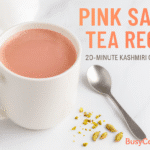
Pink Salt Tea Recipe: A Soothing Drink for Busy Days
- Prep Time: 5
- Cook Time: 15
- Total Time: 20
- Yield: 4 1x
- Category: Beverages
- Method: Stovetop
- Cuisine: Kashmiri
- Diet: Vegetarian
Description
Cozy Pink Salt Tea (Kashmiri Chai) with signature rosy hue and creamy texture. A 20-minute chemistry magic recipe that transforms green tea into beautiful pink comfort using simple pantry staples. Perfect for busy home cooks seeking cozy winter comfort with sweet-savory balance.
Ingredients
3 cups water
2–3 tbsp loose green tea leaves (or kashmiri tea leaves)
2–3 cardamom pods, lightly crushed
Heaped 1/8 tsp baking soda (plus extra pinch if needed)
1 cup ice-cold water (for cold shock)
3/4 cup whole milk
1/4 cup half-and-half (or use all milk for lighter version)
Tiny pinch kosher salt
Sugar or sweetener to taste (start with 1-2 tsp)
Crushed almonds and pistachios for garnish
Optional: saffron strand for extra aroma
Instructions
1. Set a wide pan over high heat and add 3 cups water, 2-3 tbsp green tea leaves, and 2 lightly crushed cardamom pods. Bring to a roaring boil.
2. Sprinkle in heaped 1/8 tsp baking soda (it will fizz). Stir and aerate with ladle, lifting the brew up and pouring back down for 5-6 minutes until foam deepens and liquid reduces.
3. When surface shows deep color shift, pour in 1 cup ice-cold water (no ice cubes). This cold shock deepens the pink color fast.
4. Let pot settle to simmer, then add 3/4 cup milk plus 1/4 cup half-and-half for body. Add tiny pinch of salt and sugar to taste.
5. Bring to one brief boil then immediately cut heat to protect the pink color. The tea should now show signature rosy hue.
6. Strain into cups and top with crushed almonds and pistachios. Taste and adjust sweetener as needed. Serve immediately while hot and pink color is vibrant.
Notes
CHEMISTRY TIPS: Start with small amount of baking soda – too much tastes soapy. Some tea brands won’t turn pink no matter what, so try different green tea if color won’t develop.
MAKE-AHEAD: Brew strong kahwa concentrate and store in fridge 3-4 days. Reheat gently and add milk when serving.
DAIRY-FREE: Use full-fat coconut milk or creamy oat milk. Heat gently to protect plant milk texture.
TROUBLESHOOTING: If tea stays tan instead of pink, add tiny pinch more baking soda and brief boil. Test with spoon first before adding to whole batch.
AUTHENTIC STYLE: For traditional noon chai, lean heavier on salt and skip sweetener for savory version.
PIN THIS RECIPE: Save to your Pinterest boards for cozy winter comfort!
FOLLOW BUSYCOOKLIFE: For more tested recipes that work every time and bring comfort to busy weeknights.
Nutrition
- Serving Size: 1
- Calories: 85
- Sugar: 4
- Sodium: 45
- Fat: 3
- Saturated Fat: 2
- Unsaturated Fat: 1
- Trans Fat: 0
- Carbohydrates: 8
- Fiber: 0
- Protein: 3
- Cholesterol: 8

